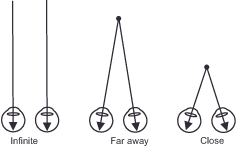Convergence and accommodation are based on the ability of the visual apparatus to evaluate eye position and eye muscle tension and are therefore also referred to as oculomotor depth criteria. Through them, we gain information about the distance relations of the fixed- and non-fixed objects, which provide us with further strong cues for constructing spatial depth.
When we look at near objects, the eyes turn inward, toward the nose, and the directions of gaze of both eyes visibly converge; we say they converge and intersect just at the fixed point. At the same time, the eye’s lens thickens so that it can focus on the object. This focusing is what we call accommodation. You can feel both if you hold a finger at arm’s length away from you, look at its tip, and then move it toward your nose. The inward turning of the eyes and the thickening of the lens cause a growing tension in the eyes. The angle at which the two visual axes converge is large at close distances and decreases the farther away the fixation point is. When set to „infinity“, the eyes are parallel and the angular amount is zero. From the registration and calculation of the convergence angle, the visual system can determine the absolute object distance in a trigonometric calculation.

At distances of less than three meters, accommodation provides the brain with effective clues for determining distance (at greater distances, we see sharply even without lens change). On the one hand, it can draw a direct conclusion about the object’s distance from the lens’s accommodation state. On the other hand, the blur, which also increases with increasing distance from the plane of fixation, allows it to draw an indirect conclusion about the distance conditions. For if we see one object in focus and another one out of focus at one moment, both must lie on different distance planes and accordingly be at different distances from us.
Next Sharpness and blur
Main Image creation, Depth and Size
Previous Stereoscopy
If you found this post useful and want to support the continuation of my writing without intrusive advertising, please consider supporting. Your assistance goes towards helping make the content on this website even better. If you’d like to make a one-time ‘tip’ and buy me a coffee, I have a Ko-Fi page. Your support means a lot. Thank you!


 Since I started my first website in the year 2000, I’ve written and published ten books in the German language about photographing the amazing natural wonders of the American West, the details of our visual perception and its photography-related counterparts, and tried to shed some light on the immaterial concepts of quantum and chaos. Now all this material becomes freely accessible on this dedicated English website. I hope many of you find answers and inspiration there. My books are on
Since I started my first website in the year 2000, I’ve written and published ten books in the German language about photographing the amazing natural wonders of the American West, the details of our visual perception and its photography-related counterparts, and tried to shed some light on the immaterial concepts of quantum and chaos. Now all this material becomes freely accessible on this dedicated English website. I hope many of you find answers and inspiration there. My books are on